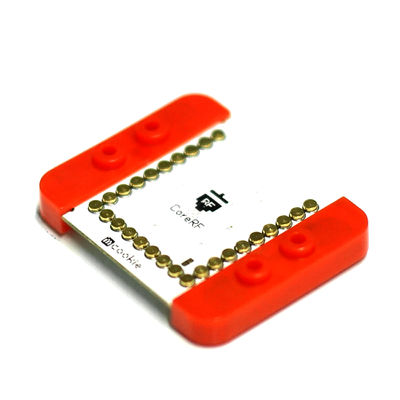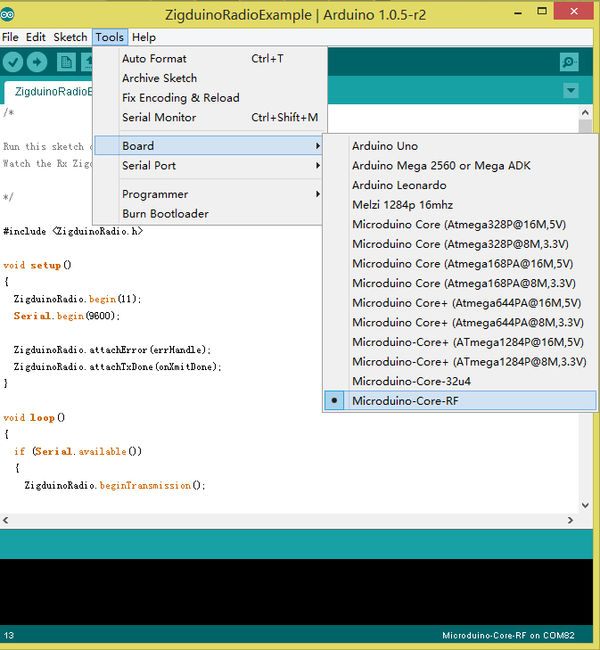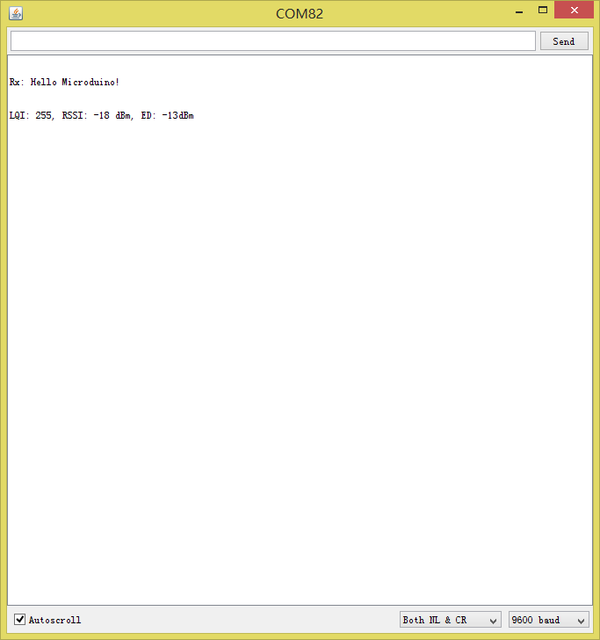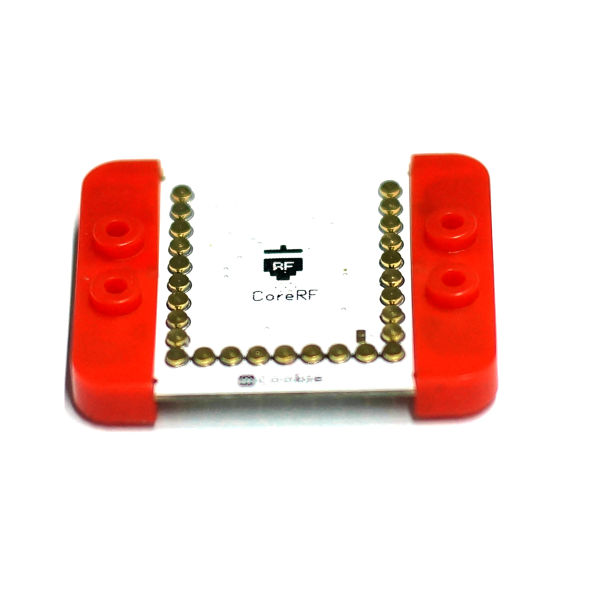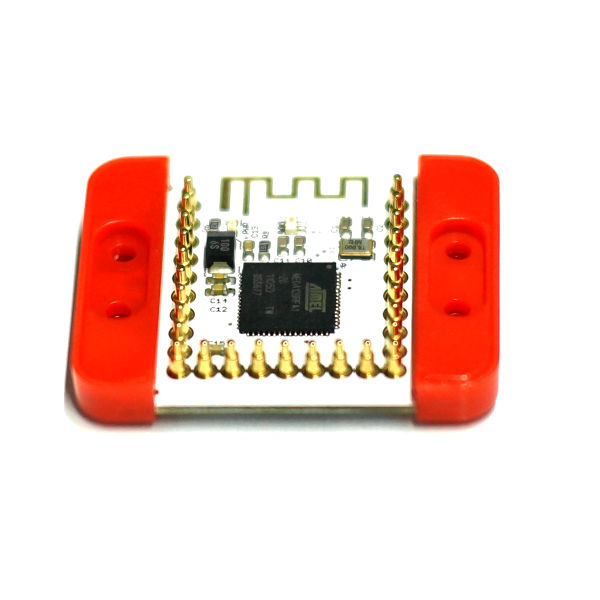Difference between revisions of "MCookie-CoreRF"
(Created page with "{| style="width: 800px;" |- | 400px|thumb|right|mCookie-CoreRF mCookie-CoreRF is AVR core board, supporting for 802.15 Wireless Protocol natively....") |
|||
| (5 intermediate revisions by the same user not shown) | |||
| Line 12: | Line 12: | ||
==Specification== | ==Specification== | ||
| − | Adopt ATmega128RFA1 | + | Adopt ATmega128RFA1 core: |
{|class="wikitable" | {|class="wikitable" | ||
|- | |- | ||
| Line 27: | Line 27: | ||
| − | * There are 22 Digital I/O(6 during them support | + | * There are 22 Digital I/O(6 during them support ADC): |
| − | *2 hard serial | + | *2 hard serial ports: |
| − | ** | + | **UART0_RX: D0 |
| − | ** | + | **UART0_TX: D1 |
| − | ** | + | **UART1_RX: D2 |
| − | ** | + | **UART1_TX: D3 |
| − | *Support 7 | + | *Support 7 PWM: |
| − | ** | + | **D4, D5, D6, D7, D8, D9, D10 |
| − | *6 external | + | *6 external interrupt: |
**Interrupt0 (pin SCL) | **Interrupt0 (pin SCL) | ||
**Interrupt1 (pin SDA) | **Interrupt1 (pin SDA) | ||
| Line 42: | Line 42: | ||
**Interrupt4 (pin D5) | **Interrupt4 (pin D5) | ||
**Interrupt5 (pin D6) | **Interrupt5 (pin D6) | ||
| − | * There are 10 Analog I/O | + | * There are 10 Analog I/O : |
| − | ** On the module labeled A0, A1, A2, A3, A6, A7, D8(A8), D9(A9), D3(A10), and D4(A11) | + | ** On the module labeled A0, A1, A2, A3, A6, A7, D8(A8), D9(A9), D3(A10), and D4(A11); |
| − | ** Each provides 10 resolution ratios(that is 0~1024). By default, the measurement range of analog voltage is the value from GND to | + | ** Each provides 10 resolution ratios(that is 0~1024). By default, the measurement range of analog voltage is the value from GND to VCC; |
** Please refer to '''[http://www.arduino.cc/en/Reference/AnalogRead analogRead()]'''function for details. | ** Please refer to '''[http://www.arduino.cc/en/Reference/AnalogRead analogRead()]'''function for details. | ||
| − | * There is one SPI | + | * There is one SPI supporter: |
** On the module labeled D13(SCK),D12(MISO),D11(MOSI),D10(SS). | ** On the module labeled D13(SCK),D12(MISO),D11(MOSI),D10(SS). | ||
| − | *There is one I2C | + | *There is one I2C supporter: |
**On the module labeled SDA(D18),SCL(D19). | **On the module labeled SDA(D18),SCL(D19). | ||
| − | *Description of | + | *Description of Pins: |
{|class="wikitable" | {|class="wikitable" | ||
| align="center" style="background:#f0f0f0;"|'''Pin''' | | align="center" style="background:#f0f0f0;"|'''Pin''' | ||
| Line 130: | Line 130: | ||
==Development== | ==Development== | ||
* 1.To download programs to Microduino-CoreRF, players need to use '''[[Microduino-USBTTL]]''' module. | * 1.To download programs to Microduino-CoreRF, players need to use '''[[Microduino-USBTTL]]''' module. | ||
| − | * 2.The tutorial of setting development environment and installing the driver is as | + | * 2.The tutorial of setting development environment and installing the driver is as following: |
**'''[[Microduino Getting start]]''' | **'''[[Microduino Getting start]]''' | ||
==Application== | ==Application== | ||
| − | [[Microduino | + | [[Microduino-Quadcopter Tutorial]] |
==Test== | ==Test== | ||
| − | Use the example program | + | Use the example program "ZigduinoRadioExample" in ZigduinoRadio library to test |
<source lang = "cpp"> | <source lang = "cpp"> | ||
void loop() | void loop() | ||
| Line 198: | Line 198: | ||
</source> | </source> | ||
This example realizes the wireless transmission function. | This example realizes the wireless transmission function. | ||
| − | Because Core RF adopts ports to download, you need to stack a Microduino-USBTTL at | + | Because Core RF adopts ports to download, you need to stack a Microduino-USBTTL at first: |
The board card , choose Microduino Core RF. | The board card , choose Microduino Core RF. | ||
[[File:154343ch79m113a77932i7.jpg|600px|thumb|center]] | [[File:154343ch79m113a77932i7.jpg|600px|thumb|center]] | ||
| − | After downloading programs to two Core-RF, open the serial port monitor, and input | + | After downloading programs to two Core-RF, open the serial port monitor, and input "Hello Microduino!", then you will get the following result: |
[[File:Result.png|600px|thumb|center]] | [[File:Result.png|600px|thumb|center]] | ||
[[File:Result1.png|600px|thumb|center]] | [[File:Result1.png|600px|thumb|center]] | ||
| Line 218: | Line 218: | ||
[[file:mCookie-CoreRF-b.JPG|thumb|600px|center]] | [[file:mCookie-CoreRF-b.JPG|thumb|600px|center]] | ||
| − | |||
| − | |||
| − | |||
|- | |- | ||
| | | | ||
|} | |} | ||
Latest revision as of 09:45, 28 September 2016
|
mCookie-CoreRF is AVR core board, supporting for 802.15 Wireless Protocol natively. It integrates 802.15.4 Wireless Protocol modules, including ZigBee, MAC/6LoWPAN and RF4CE. ContentsFeatures
SpecificationAdopt ATmega128RFA1 core:
File:MCookie-CoreRf-pin.jpg Microduino-CoreRF Pins File:MCookie-CoreRFpinlayout.jpg Microduino-CoreRF Components Documents
ATmega128RFA1: http://www.atmel.com/zh/cn/devices/ATMEGA128RFA1.aspx?tab=documents Development
ApplicationMicroduino-Quadcopter Tutorial TestUse the example program "ZigduinoRadioExample" in ZigduinoRadio library to test void loop()
{
if (Serial.available())
{
ZigduinoRadio.beginTransmission();
Serial.println();
Serial.print("Tx: ");
while(Serial.available())
{
char c = Serial.read();
Serial.write(c);
ZigduinoRadio.write(c);
}
Serial.println();
ZigduinoRadio.endTransmission();
}
if (ZigduinoRadio.available())
{
Serial.println();
Serial.print("Rx: ");
while(ZigduinoRadio.available())
Serial.write(ZigduinoRadio.read());
Serial.println();
Serial.print("LQI: ");
Serial.print(ZigduinoRadio.getLqi(), 10);
Serial.print(", RSSI: ");
Serial.print(ZigduinoRadio.getLastRssi(), 10);
Serial.print(" dBm, ED: ");
Serial.print(ZigduinoRadio.getLastEd(), 10);
Serial.println("dBm");
}
delay(100);
}
void errHandle(radio_error_t err)
{
Serial.println();
Serial.print("Error: ");
Serial.print((uint8_t)err, 10);
Serial.println();
}
void onXmitDone(radio_tx_done_t x)
{
Serial.println();
Serial.print("TxDone: ");
Serial.print((uint8_t)x, 10);
Serial.println();
}This example realizes the wireless transmission function. Because Core RF adopts ports to download, you need to stack a Microduino-USBTTL at first: The board card , choose Microduino Core RF. After downloading programs to two Core-RF, open the serial port monitor, and input "Hello Microduino!", then you will get the following result: The test is completed now. FAQPurchaseHistoryGallery | |||||||||||||||||||||||||||||||||||||||||||||||||||||||||||||||||||||||||||||||||||||||||||||||||||||||||||||||||||||||||||||||||||||||||||||||||||||||||||||||||||||||||||||||||||||||||||||||||||||||||||||||||||||||||||||||||||||||||||||||||||||||||||||||||||||||||||||||||||||||||||||||||||||||||||||||||||||||||||||
